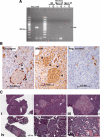Multiple endocrine neoplasia type 1 deletion in pancreatic alpha-cells leads to development of insulinomas in mice
- PMID: 20555035
- PMCID: PMC2940531
- DOI: 10.1210/en.2009-1251
Multiple endocrine neoplasia type 1 deletion in pancreatic alpha-cells leads to development of insulinomas in mice
Abstract
The pancreatic alpha- and beta-cells are critical components in regulating blood glucose homeostasis via secretion of glucagon and insulin, respectively. Both cell types are typically localized in the islets of Langerhans. However, little is known about the roles of paracrine interactions that contribute to their physiological functions. The lack of suitable cell lines to study alpha- and beta-cells interactions have led us to develop an alpha-cell-specific Cre-expressing transgenic line utilizing a glucagon promoter sequence, the Glu-Cre transgenic mouse. Here, we demonstrate that the Glu-Cre could specifically and efficiently excise floxed target genes in adult islet alpha-cells. We further showed that deletion of the tumor suppressor gene, multiple endocrine neoplasia type 1 (Men1), in alpha-cells led to tumorigenesis. However, to our surprise, the lack of Men1 in alpha-cells did not result in glucagonomas but rather beta-cell insulinomas. Because deletion of the Men1 alleles was only present in alpha-cells, our data suggested that cross communication between alpha- and beta-cells contributes to tumorigenesis in the absence of Men1. Together, we believed that the new model systems described here will allow future studies to decipher cellular interactions between islet alpha- and beta-cells in a physiological context.
Figures




Similar articles
-
Alpha cell-specific Men1 ablation triggers the transdifferentiation of glucagon-expressing cells and insulinoma development.Gastroenterology. 2010 May;138(5):1954-65. doi: 10.1053/j.gastro.2010.01.046. Epub 2010 Feb 2. Gastroenterology. 2010. PMID: 20138042
-
Of mice and MEN1: Insulinomas in a conditional mouse knockout.Mol Cell Biol. 2003 Sep;23(17):6075-85. doi: 10.1128/MCB.23.17.6075-6085.2003. Mol Cell Biol. 2003. PMID: 12917331 Free PMC article.
-
The Cell Death Inhibitor ARC Is Induced in a Tissue-Specific Manner by Deletion of the Tumor Suppressor Gene Men1, but Not Required for Tumor Development and Growth.PLoS One. 2015 Dec 28;10(12):e0145792. doi: 10.1371/journal.pone.0145792. eCollection 2015. PLoS One. 2015. PMID: 26709830 Free PMC article.
-
Oncogenic co-operation in beta-cell tumorigenesis.Endocr Relat Cancer. 2001 Dec;8(4):307-14. doi: 10.1677/erc.0.0080307. Endocr Relat Cancer. 2001. PMID: 11733227 Review.
-
Alpha cell regulation of beta cell function.Diabetologia. 2020 Oct;63(10):2064-2075. doi: 10.1007/s00125-020-05196-3. Epub 2020 Sep 7. Diabetologia. 2020. PMID: 32894317 Free PMC article. Review.
Cited by
-
Characterization of pancreatic glucagon-producing tumors and pituitary gland tumors in transgenic mice overexpressing MYCN in hGFAP-positive cells.Oncotarget. 2016 Nov 15;7(46):74415-74426. doi: 10.18632/oncotarget.12766. Oncotarget. 2016. PMID: 27769070 Free PMC article.
-
GSK-3β protein phosphorylates and stabilizes HLXB9 protein in insulinoma cells to form a targetable mechanism of controlling insulinoma cell proliferation.J Biol Chem. 2014 Feb 28;289(9):5386-98. doi: 10.1074/jbc.M113.533612. Epub 2014 Jan 14. J Biol Chem. 2014. PMID: 24425879 Free PMC article.
-
Elimination of von Hippel-Lindau function perturbs pancreas endocrine homeostasis in mice.PLoS One. 2013 Aug 20;8(8):e72213. doi: 10.1371/journal.pone.0072213. eCollection 2013. PLoS One. 2013. PMID: 23977255 Free PMC article.
-
Multiple Endocrine Neoplasia Type 1: Latest Insights.Endocr Rev. 2021 Mar 15;42(2):133-170. doi: 10.1210/endrev/bnaa031. Endocr Rev. 2021. PMID: 33249439 Free PMC article. Review.
-
Alternative splicing generates isoform diversity in MEN1.Endocr Oncol. 2024 Nov 26;4(1):e240014. doi: 10.1530/EO-24-0014. eCollection 2024 Jan 1. Endocr Oncol. 2024. PMID: 39649118 Free PMC article.
References
-
- Gromada J, Franklin I, Wollheim CB 2007 α-Cells of the endocrine pancreas: 35 years of research but the enigma remains. Endocr Rev 28:84–116 - PubMed
-
- Bonner-Weir S, Orci L 1982 New perspectives on the microvasculature of the islets of Langerhans in the rat. Diabetes 31:883–889 - PubMed
-
- Chandrasekharappa SC, Guru SC, Manickam P, Olufemi SE, Collins FS, Emmert-Buck MR, Debelenko LV, Zhuang Z, Lubensky IA, Liotta LA, Crabtree JS, Wang Y, Roe BA, Weisemann J, Boguski MS, Agarwal SK, Kester MB, Kim YS, Heppner C, Dong Q, Spiegel AM, Burns AL, Marx SJ 1997 Positional cloning of the gene for multiple endocrine neoplasia-type 1. Science 276:404–407 - PubMed
-
- Lemmens I, Van de Ven WJ, Kas K, Zhang CX, Giraud S, Wautot V, Buisson N, De Witte K, Salandre J, Lenoir G, Pugeat M, Calender A, Parente F, Quincey D, Gaudray P, De Wit MJ, Lips CJ, Höppener JW, Khodaei S, Grant AL, Weber G, Kytölä S, Teh BT, Farnebo F, Thakker RV 1997 Identification of the multiple endocrine neoplasia type 1 (MEN1) gene. The European consortium on MEN1. Hum Mol Genet 6:1177–1183 - PubMed
Publication types
MeSH terms
Substances
Grants and funding
LinkOut - more resources
Full Text Sources
Medical
Molecular Biology Databases

